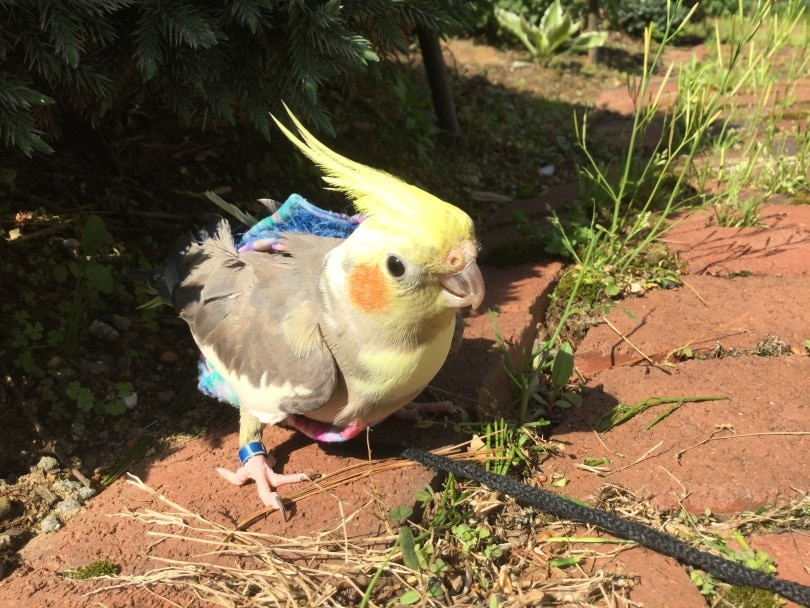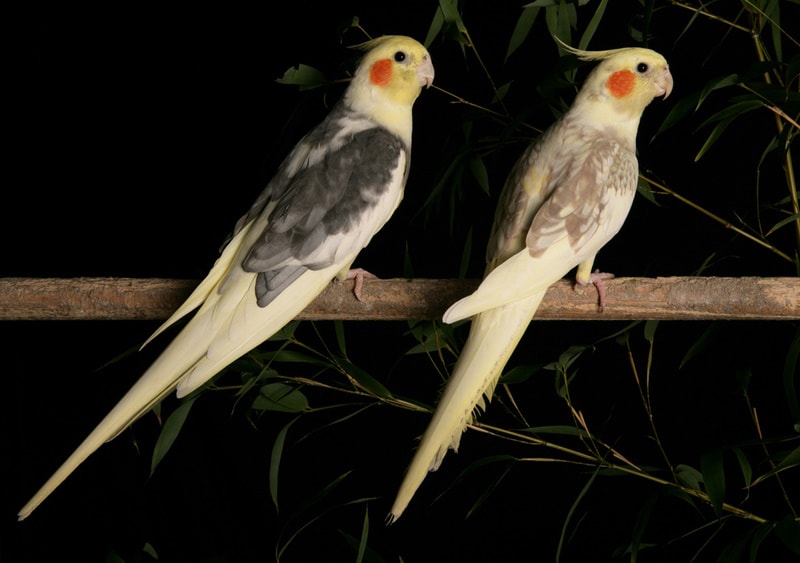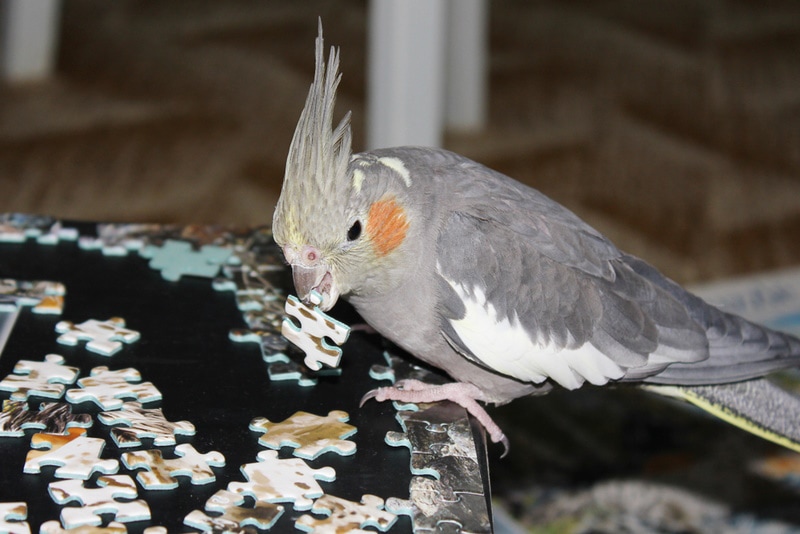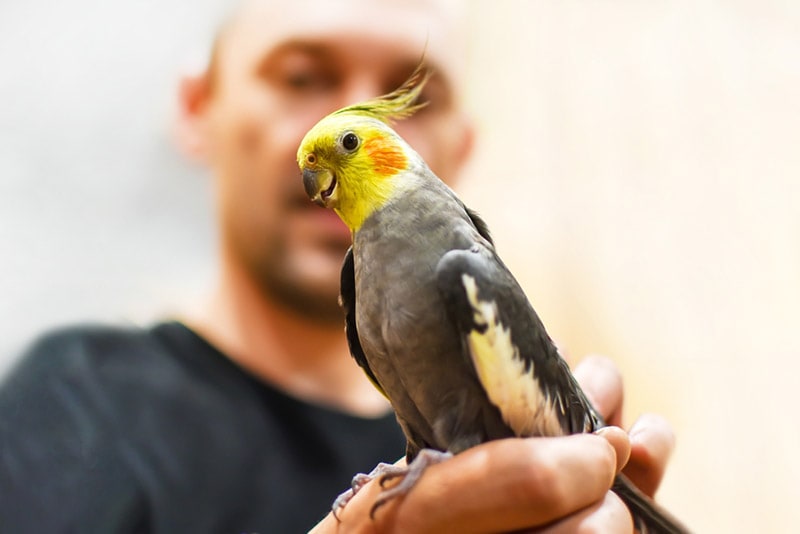Pied Cockatiel: Pictures, Facts, & History

Updated on

Click to Skip Ahead
The Pied Cockatiel is a color mutation of the Cockatiel that does not occur in wild Cockatiels and is only available in domestic, pet Cockatiels. It has the same friendly disposition as the Cockatiel, combined with the pied coloring. This means blotches and patches of color on the body and wings of the bird. The most prized of these birds are those that have symmetrical blotches and patterns, but this is rare and it cannot be predicted during breeding.
| Height: | 12–14 inches |
| Weight: | 2.5–5 ounces |
| Lifespan: | 10–15 years |
| Colors: | Gray, yellow, white, orange |
| Suitable For: | First-time or experienced bird owners looking for an inexpensive, friendly bird |
| Temperament: | Affectionate, loving, friendly, social, intelligent, fun |
The Cockatiel is one of the most popular pet birds because it is inexpensive to buy, relatively easy to care for, and not only tolerates handling but usually enjoys it. This intelligent bird can be taught some tricks and it will usually get along with all members of the family as well as visitors. It can live 10 years or more, so it has plenty of opportunity to become an integral part of the family.
The pied color variation of the Cockatiel has the same body colors as other cockatiels but it has blotches or patches of one of the colors. This means that it could have white or yellow blotches on a gray background, or vice versa. It is a popular coloring that was intentionally bred in the 1950s and is one of the easier variations to find on the pet market. The pied coloring is not a natural variation so you cannot see Pied Cockatiels in the wild.
Pied Cockatiel Breed Characteristics

The Earliest Records of Pied Cockatiels in History
Pied Cockatiels do not occur naturally so they cannot be seen in the wild. They were bred by Mr. D. Putman, of San Diego, California, after decades of attempting to breed different color variations and mutations. The Pied Cockatiel is believed to be one of, if not the first mutation of its kind which means that it has become very popular in the intervening years.
When Mr. Putnam died in 1951, his stock of Pied Cockatiels was taken on by Mr. Hubbell. He continued breeding the birds. At the same time as Mr. Hubbell continued his breeding efforts, Mrs. R Kersh was also breeding Pied Cockatiels of her own. Although it is possible that there was some genetic link between the original birds of both stocks, the two breeding programs were unrelated.
How Pied Cockatiels Gained Popularity
It is believed that early efforts to breed Pied Cockatiels met with some challenges, specifically that there were issues with the fertility of the first birds. By the late 1960s, there were only around 100 of the birds. They sold for a considerable amount, ranging from $100 in the U.S. to $200 in Europe.
If one parent has the Pied gene, some patches will show up, but if both parents possess the gene, the resulting Cockatiel will have vibrant and clear Pied patterning. It is possible that early efforts were made to try and breed specific patterns into the bird. The most appealing patterns show symmetry on both sides of the body and with a deep yellow background. This hunt for the perfect pattern may have hindered the overall development.
Since the 1960s and 1970s, the Pied Cockatiel has become increasingly common and the variation is very popular with owners and breeders today. The perfectly symmetrical pattern is still the most highly sought after, and these are the ones that tend to attract the highest price, but some Pied Cockatiels with minimal Pied markings can be bought for around the same price as standard Cockatiels

Formal Recognition of Pied Cockatiels
The Pied Cockatiel is widely recognized as an official mutation of the Cockatiel and can therefore be shown in exhibitions and competitions.
Top 3 Unique Facts About Pied Cockatiels
1. Pied Was the First Cockatiel Color Mutation
Cockatiels have been popular as pets for centuries, but the Pied Cockatiel was the first color mutation. Early records are not available, and the mutation only really came to the fore following the death of breeder Mr. D. Putnam in 1951. As he already had a stock of Pied Cockatiels at this time, his breeding efforts must have started sometime before this year, and most likely in the 1940s.
2. Male Cockatiels Tend to Be Better Whistlers

Whatever the color mutation, Cockatiels can make very good whistlers. They also vocalize and mimic noises that they hear regularly. This means that a Cockatiel can make a very convincing impression of alarm clocks and other noises that it regularly hears. Although it is rare, a small number of Cockatiels can even mimic human voices. It is the male Cockatiel that is known for being the most vocal. It is the most likely to talk and will make more noise, typically, than the female Cockatiel.
3. They Can Live as Long as Dogs
With an average lifespan of 10 to 14 years, the Cockatiel’s longevity is comparable to that of some dog breeds and cats. This is good news for owners because it enables them to get attached and form a close bond with the bird. It does mean that taking on a Cockatiel pet requires a long-term commitment, though, and you will need to be able to provide adequate care and living conditions for the bird throughout its life.
Does the Pied Cockatiel Make a Good Pet?
Cockatiels make very good pets and are considered a good choice as a first bird pet for owners. They are affectionate and friendly, intelligent, and they have a good lifespan. They do require a decent amount of cage space, however, and they can be a bit messy and dusty. The Pied Cockatiel has the same characteristics and traits as any other Cockatiel which makes it a great pet bird choice too.
Although they are quite small birds, certainly when compared to other Parrots, Cockatiels are big on character. Once you have formed a close bond with yours, you can expect it to greet you at the cage door whenever you enter the room. You can also train it to hop onto your finger, encourage it to sit on your shoulder while you’re watching TV, and you can create your own games involving cage toys and other items.
You will have to embark on some regular cleanup, however. The Cockatiel may flick its food and other debris out of its cage, and although its poop is small, this can make it difficult to locate outside the cage. And, unfortunately, while they are intelligent and can be trained to do a lot of things, Cockatiels cannot be litter trained.
Conclusion
Pied Cockatiels are a popular color variant of Cockatiel. They are believed to have been the first color variant and were likely first intentionally bred in the 1940s. Since then, they have become a popular variation with some of the most highly sought-after being those with consistent, uniform, and symmetrical pie patterning on the wings and obvious color variations on the whole body.
The Pied Cockatiel makes a friendly, lively, and entertaining family pet that may, albeit very unusually, learn to mimic a few human words, but that will certainly keep you entertained with its whistles and other vocalizations.
See also:
Featured Image Credit: Ona Leiwant, Shutterstock











